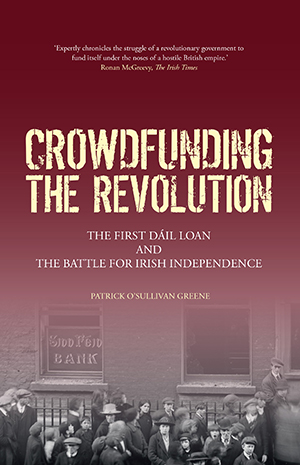CROWDFUNDING THE REVOLUTION: the First Dáil Loan and the battle for Irish independence
Published in Book Reviews, Book Reviews, Issue 2 (March/April 2021), Reviews, Volume 29PATRICK O’SULLIVAN GREENE
Eastwood Books
€20
ISBN 9781916137585
Reviewed by Paschal Donohoe, TD
Paschal Donohoe is the Minister for Finance.
 The National Treasury Management Agency has a low public profile but is essential to the operation of our state. The phrase ‘treasury’ is suggestive of great riches, of bullion residing in secure vaults for national use. The reality, however, is more prosaic and far more important. This State body is responsible for the management of our national borrowing and debt and will borrow €16–20 billion for Irish public services in 2021 to help pay the wages of public servants and Covid wage subsidy schemes.
The National Treasury Management Agency has a low public profile but is essential to the operation of our state. The phrase ‘treasury’ is suggestive of great riches, of bullion residing in secure vaults for national use. The reality, however, is more prosaic and far more important. This State body is responsible for the management of our national borrowing and debt and will borrow €16–20 billion for Irish public services in 2021 to help pay the wages of public servants and Covid wage subsidy schemes.
The link between the legitimacy and the solvency of a state is fundamental. At the most basic level, money must be available to pay for public services. There are two ways in which this can be achieved: through the current generation paying their taxes, or through future generations paying by means of borrowing undertaken today. This link is clear for existing states but is also clear to those leading attempts to create states—even, or especially, during times of revolution. So, when medieval Genoa, Venice and Florence were at the frontier of developing city-states, their efforts were enabled by their ability to issue debt. Similarly, the enactment of the Funding Act of 1790 was a seminal moment in the creation of the American state, with the issuance of federal securities creating new federal income.
Revolutionaries and the creators of fledgling states quickly confront the need to pay for the institutions that they seek to create. Efforts to create a new Irish state confronted similar challenges. A seminal moment in these endeavours is the focus of this book. Crowdfunding is full of vivid sketches of figures who are moved from the background in this phase of our history to centre stage as their efforts to pay for a new state are detailed.
The need for these labours became apparent in the early days of the First Dáil in 1919. In April, Éamon de Valera told the Dáil that ‘It is obvious that the work of our Government cannot be carried on without funds’, but financial markets, the obvious source of such funds, would only lend to recognised sovereign governments. As the author concludes: ‘That left private individuals. The plan was to crowdfund the revolution.’
Michael Collins was the central figure in raising a loan that was to fund a diplomatic service as well as to provide supports for the fishing industry. An objective of £500,000 was set, with America and small domestic contributions targeted as the sources of funding. The stakes were very high, as the author writes: ‘The credibility of the Dáil Government as a viable alternative to the Dublin Castle administration was at stake. Without money, the Dáil Éireann experiment could end in failure …’.
Each member of the Dáil was required to set up a fund-raising committee. A public advertising campaign was launched, and 250,000 Loan prospectuses were distributed. The author argues that these prominent efforts were a catalyst for a more vigorous campaign of suppression waged by Dublin Castle. Patrick J. Little of the New Ireland journal is quoted as saying that ‘The British Government now aims at making it physically impossible to float any loan which will establish industries and prevent emigration’.
Efforts to support the Loan became increasingly sophisticated as challenges grew. An alternative postal system was created, a National Land Bank was founded, and additional resources were devoted to the putative Department of Finance, with offices in Harcourt Street and Mary Street. In correspondence with de Valera, Collins wrote that ‘[You] can scarcely conceive the limits to which the English have carried their repressions and suppressions against this loan … and with a renewed determination and savagery’.
The leader of these reprisals was Alan Bell, an Offaly-born magistrate who ‘had been using the Crimes Act to suppress political agitation for longer than most of the Sinn Féin leaders had been alive’. His interrogation of the leading organisers of the Loan form the most vivid passages of this book. A sense of drama pulses through these pages. The effectiveness of these interrogations led to his assassination.
This leads to one of two conclusions. First, that the shooting of Bell was related to his financial investigations and not to other investigations that he was leading. This means that the campaign to stop the Dáil Loan was an important catalyst for the events that led to the War of Independence. Second, that ‘The raising of the First Dáil Loan was an exceptional achievement for an alternative government setting up a counter-state in open defiance of the established and hostile British administration’. This claim is supported not just by the scale of the efforts but also by the result. By October 1920, £371,849 had been raised. By the following year the Loan had raised £400,000. A second Loan campaign was launched in 1921.
The Loan was repaid in 1924, with Ernst Blyth stating that ‘If it had not been for the generosity and faith of the people who subscribed to the loan, there would be no Free State today’.
The quality of writing and the pace of storytelling ensure that this is not a niche or specialist work of history. This is a compelling read. I wish I had written it myself.
















